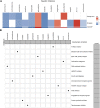CAMSAP1 Mutation Correlates With Improved Prognosis in Small Cell Lung Cancer Patients Treated With Platinum-Based Chemotherapy
- PMID: 35087829
- PMCID: PMC8787262
- DOI: 10.3389/fcell.2021.770811
CAMSAP1 Mutation Correlates With Improved Prognosis in Small Cell Lung Cancer Patients Treated With Platinum-Based Chemotherapy
Abstract
Platinum-based chemotherapy is the first-line treatment for small cell lung cancer (SCLC). However, due to patients developing a resistance to the drug, most experience relapse and their cancer can become untreatable. A large number of recent studies have found that platinum drug sensitivity of various cancers is affected by specific gene mutations, and so with this study, we attempted to find an effective genetic biomarker in SCLC patients that indicates their sensitivity to platinum-based drugs. To do this, we first analyzed whole exome sequencing (WES) and clinical data from two cohorts to find gene mutations related to the prognosis and to the platinum drug sensitivity of SCLC patients. The cohorts used were the Zhujiang cohort (N = 138) and the cohort reported by George et al. (N = 101). We then carried out gene set variation analysis (GSVA) and gene set enrichment analysis (GSEA) to investigate possible molecular mechanisms through which these gene mutations affect patient prognosis and platinum drug sensitivity. We found that for SCLC patients, CAMSAP1 mutation can activate anti-tumor immunity, mediate tumor cell apoptosis, inhibit epithelial-mesenchymal transition (EMT), improve prognosis, and improve platinum drug sensitivity, suggesting that CAMSAP1 mutation may be a potential biomarker indicating platinum drug sensitivity and patient prognosis in SCLC.
Keywords: CAMSAP1; biomarker; drug sensitivity; platinum-based chemotherapy; small cell lung cancer.
Copyright © 2022 Yi, Qiu, Yao, Lin, Qin, Sha, Wei, Wang, Cheng, Zhang, Luo and Shen.
Conflict of interest statement
The authors declare that the research was conducted in the absence of any commercial or financial relationships that could be construed as a potential conflict of interest.
Figures







References
-
- Ahmed N., Escalona R., Leung D., Chan E., Kannourakis G. (2018). Tumour Microenvironment and Metabolic Plasticity in Cancer and Cancer Stem Cells: Perspectives on Metabolic and Immune Regulatory Signatures in Chemoresistant Ovarian Cancer Stem Cells. Semin. Cancer Biol. 53, 265–281. 10.1016/j.semcancer.2018.10.002 - DOI - PubMed
-
- Al-Khayal K., Vaali-Mohammed M.-A., Elwatidy M., Traiki T. B., Al-Obeed O., Azam M., et al. (2020). Correction to: A Novel Coordination Complex of Platinum (PT) Induces Cell Death in Colorectal Cancer by Altering Redox Balance and Modulating MAPK Pathway. BMC Cancer 20 (1), 834. 10.1186/s12885-020-07245-x - DOI - PMC - PubMed
-
- Ardizzoni A., Hansen H., Dombernowsky P., Gamucci T., Kaplan S., Postmus P., et al. (1997). Topotecan, a New Active Drug in the Second-Line Treatment of Small-Cell Lung Cancer: A Phase II Study in Patients with Refractory and Sensitive Disease. The European Organization for Research and Treatment of Cancer Early Clinical Studies Group and New Drug Development Office, and the Lung Cancer Cooperative Group. J. Clin. Oncol. 15 (5), 2090–2096. 10.1200/JCO.1997.15.5.2090 - DOI - PubMed
LinkOut - more resources
Full Text Sources

